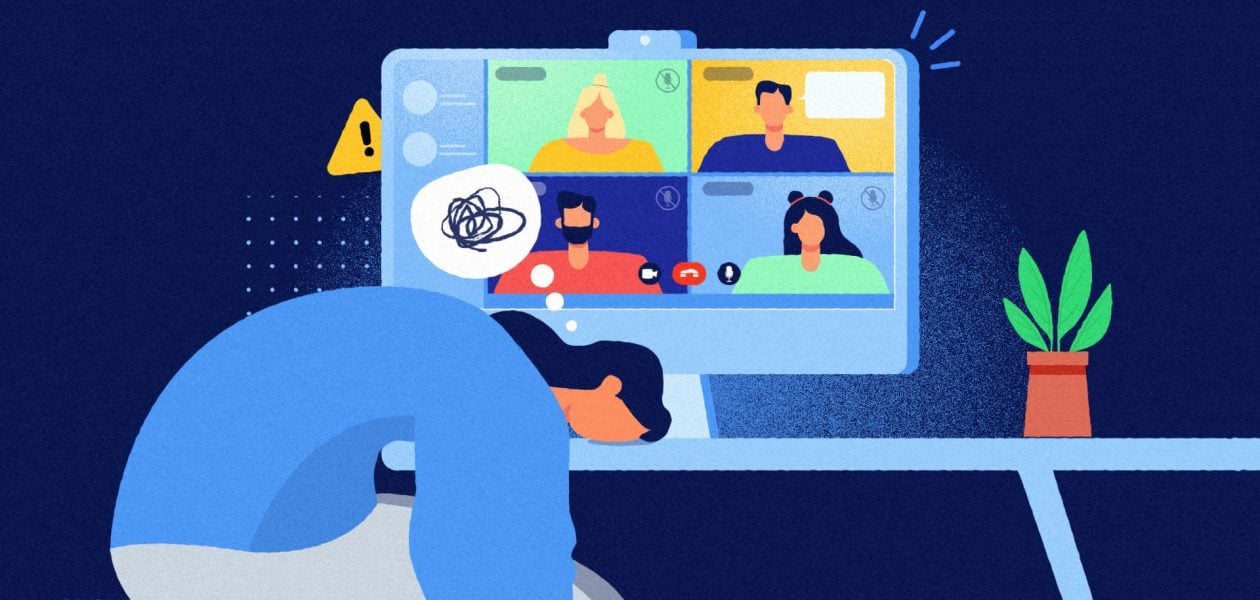In the era of ubiquitous video conferencing, the prevalence of virtual meetings has skyrocketed, impacting both professional and personal spheres. If you find yourself drained after a day filled with virtual interactions, you’re not alone. The term “Zoom Fatigue” has become increasingly prevalent, with even Harvard Business Review acknowledging its emergence in social media and Google searches since the early days of the pandemic.
What is Zoom Fatigue?
Stanford University’s Zoom Exhaustion and Fatigue (ZEF) scale sheds light on this phenomenon, revealing that the frequency and duration of video meetings are linked to higher levels of mental fatigue and diminished focus.
As we navigate the challenges of remote work and virtual communication, it’s crucial to understand what causes Zoom fatigue and explore effective strategies to combat it.
Symptoms of Zoom Fatigue
Video calling fatigue symptoms vary from person to person. Some may encounter only one, while others may experience several. The condition may be exacerbated by existing mental health problems or other forms of stress as a result of working from home.
However, it’s critical to note that attending a meeting or two will not leave you completely drained. Although, it can be exhausting if your profession demands you to take part in several video chat meetings on a daily basis.
Here are some of the most common symptoms of Zoom Fatigue:
- Headaches or migraines 🤕
- Social Anxiety 😰
- Feelings of “burnout”(i.e. feeling overworked) 😫
- Social detachment ⛔
- Depression 😔
- Pessimism 👎
- Sensitivity to light or sound 💥
- Lack of motivation 🙅♂️
- Low productivity 📉
Why video calls can be draining?
Zoom fatigue, also known as video call fatigue or screen fatigue, refers to the profound exhaustion associated with virtual meetings. This fatigue isn’t exclusive to the Zoom platform but extends to any video conferencing program.

The intensity of concentration required during video calls, coupled with the lack of non-verbal cues and increased cognitive load, contributes to mental weariness. Unlike in-person meetings, where peripheral vision and side conversations provide breaks, video calls demand a continuous gaze at the screen.
This constant scrutiny, along with self-conscious behaviors induced by seeing one’s reflection, intensifies the cognitive strain. The symptoms of Zoom fatigue vary from headaches and social anxiety to decreased motivation and productivity.
Combatting Zoom Fatigue: 9 proven strategies

Zooming fatigue is real and creates exhaustive sensations and other unpleasant problems. While all of this may sound like bad news, there is some good news: with the proper practices, it is easy to manage zoom fatigue.
Here are 9 tips on how to prevent “Zoom Fatigue” and get you started for your next meeting.
1. Minimize visual distractions 🌟
- Choose a simple and neutral virtual background to avoid overwhelming visuals.
- Opt for solid colors or subtle patterns that won’t compete for attention.
- Consider using tools that allow you to blur the background, keeping the focus on you.
2. Use camera thoughtfully 📷
- Turn on your camera selectively, especially during lengthy meetings or when actively participating.
- Communicate with your team about when cameras are necessary, promoting a shared understanding of camera etiquette.
- Utilize the “camera off” option during periods of listening or when you need a break from constant visibility.
3. Take mini-breaks ⏱️
- Use breaks between calls to stretch, walk around, or perform quick exercises to prevent physical strain.
- Consider setting reminders for mini-breaks to maintain a consistent routine.
- Use this time to glance away from screens to reduce eye fatigue.
4. Limit self-view 📵
- Adjust video call settings to hide your self-view or position it in a less distracting part of the screen.
- This minimizes self-conscious behaviors and allows you to concentrate on others’ contributions.
- Encourage team members to follow suit to create a more focused and collaborative virtual environment.
5. Avoid multitasking 🚫
- Create a dedicated workspace to minimize external distractions eventually reducing zoom fatigue.
- Close irrelevant tabs and applications during video calls to stay fully engaged.
- Communicate with colleagues about the importance of focused attention during meetings.
6. Opt for asynchronous meetings 🔄
- Prioritize asynchronous communication for tasks that don’t require real-time collaboration.
- Utilize project management tools and communication platforms that support asynchronous updates and discussions.
- This approach allows team members to manage their time effectively and reduces the overall reliance on video calls.
7. Balance formality with banter 💬
- Start or end meetings with brief, light-hearted discussions to foster a sense of camaraderie.
- Encourage team members to share non-work-related updates to maintain a human connection.
- Use dedicated channels or time slots for casual conversations to strike a balance between work and social interaction.
8. Mental preparation 🧠
- Practice mindfulness techniques, such as deep breathing or meditation, before meetings to enhance focus.
- Encourage team members to take a few moments for mental preparation to create a conducive mindset for productive discussions.
- Foster an understanding within the team that mental preparation is a valuable practice for effective collaboration.
9. Designate meeting-free days 📅
- Collaborate with colleagues to establish specific days without scheduled meetings.
- Use these days for focused, uninterrupted work on individual tasks or projects.
- Implement a shared calendar or scheduling tool to coordinate meeting-free days, ensuring team-wide participation and commitment.
Summary
In summary, while the convenience of video conferencing tools is undeniable, their overuse can lead to significant fatigue. Recognizing the symptoms and applying these strategies can help create a healthier and more productive virtual work environment. Embrace these tips to enhance your overall well-being and combat the challenges of Zoom fatigue. 🚀



